|

What To Stop And Look For in the Black Hills
words
and photos: Rachel
L. Miller
It's
the kind of air that is so clean and crisp that
it fills lungs much like love fills the heart. It's
the kind of air that belongs only to the night and
only in the most quiet, natural places. It's the
kind of air that awakens my flesh into thousands
of tiny goosebumps and prompts me to hug myself
to keep warm.
And
it's the air, coolly comforting, that temporarily
wards off tears as I whisper the words to the "Star-Spangled
Banner." All eyes are focused on the four presidents
carved in stone, all lips are moving in synch to
the national anthem, and I imagine most of the Mount
Rushmore visitors this night are just as awestruck
as I am.
The
glow from the spotlights poised on the presidents
is dim at first, but slowly grows brighter until
the carving is illuminated in a brilliant white-orange
and is all that can be seen clearly in the deep
shroud of night. I
try not to cry as the amphitheater erupts into applause
for this impressive monument to the American spirit,
but I'm comforted by the voice of a nearby woman,
"Whew, I'm getting all teary-eyed over here.
It's hard not to."
So
I don't feel sappy or corny for having an emotional
reaction, I just go with it and feel the love. It's
beautiful and patriotic and makes me wish I'd made
this journey much earlier in my life.
Through
a three-day tour of the Black Hills region of South
Dakota, I realized the same can be said about the
area and its attractions in general. There were
many times during my road trip through the region
that I looked out across the stunning scenery, thinking,
"How was it that I never managed to make it
out here?"
Patriotism
is high and the Black Hills (in western South Dakota)
is home to many uplifting and proud-to-be-American
attractions. Add in the fun road tripping possibilities,
and you've got an inexpensive, educational, great-for-all-ages
getaway. Once you explore the Black
Hills National Forest, there's still
so much to do (and see), that's it would be virtually
impossible to get to everything. So we've put together
our own list of must-sees:
 The
attraction that obviously stands out the most is
Mount Rushmore National
Memorial, featuring the faces of four
American presidents: George Washington, Thomas Jefferson,
Theodore Roosevelt, and Abraham Lincoln. Nestled
in the Black Hills in the town of Keystone, the
faces are 60 feet tall and are located 500 feet
up the mountain. The
attraction that obviously stands out the most is
Mount Rushmore National
Memorial, featuring the faces of four
American presidents: George Washington, Thomas Jefferson,
Theodore Roosevelt, and Abraham Lincoln. Nestled
in the Black Hills in the town of Keystone, the
faces are 60 feet tall and are located 500 feet
up the mountain.
Nothing
could've prepared me for my first glimpse of the
mountain. One of my friends told me (rather cynically)
before I left on the trip: "Be warned. It's
really not as big as you think it is." Another
friend chimed in, "Yeah, it's like the Mona
Lisa. Looks much bigger in pictures."
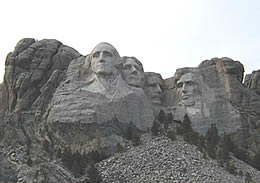 So
as we rounded a curve into the park and I caught
a glimpse of George Washington's stoic profile,
clean against an ice blue sky, I was taken aback.
My friends had either lied to me or had completely
distorted memories. Mount Rushmore is not small
by any means. It is enormous and captivating - in
fact the word I overheard the most while exploring
the area was a simple, "Wow." So
as we rounded a curve into the park and I caught
a glimpse of George Washington's stoic profile,
clean against an ice blue sky, I was taken aback.
My friends had either lied to me or had completely
distorted memories. Mount Rushmore is not small
by any means. It is enormous and captivating - in
fact the word I overheard the most while exploring
the area was a simple, "Wow."
Children,
little hands grasping ice cream cones, looking upward
at the mountain, said it. Older men, holding canes
and cameras and wearing knee-length black dress
socks with sandals, said it. And yes, even travel
writers, hands full of brochures and notepads, said
it. No one, save the unflappable and elusive moutain
goat, is immune to the stunning force that is Mount
Rushmore.
Next on our list is the work-in-progress that is Crazy Horse Memorial, the world's largest sculpture. To say that the mountain memorial is colassal is a vast understatement. It's beyond such description, with just the head of Crazy Horse measuring nine stories tall. The horse's head, on which work has just begun, will measure 22 stories in height. All in all, the carving will be 563 feet high and 641 feet long. But words and photos cannot describe the carving, you must see it for yourself.
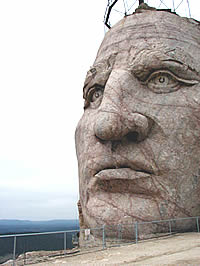 |
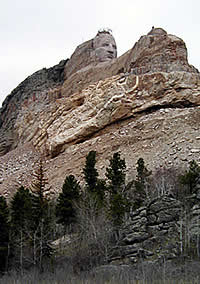 |
Close-up view of Crazy Horse's face (top) & view of carving (bottom) |
The story of how the memorial began is almost as incredible as the sculpture itself. Sculptor Korczak Ziolkowski grew up in Boston in a series of foster homes and was completely self-taught, never having taken an art class. In 1939, Lakota Chief Henry Standing Bear wrote to Ziolkowski, inviting him to the Black Hills to carve a mountain memorial to Crazy Horse: "My fellow chiefs and I would like the white man to know the red man has great heroes, too."
Seven years later, Ziolkowski moved to the wilderness of the Black Hills, where he lived in a tent at the base of mountain. He married and had 10 children, who he schooled in the art of mountain carving. His wife, Ruth, and seven children continue to work at, expand and carry on his dream after his death in 1982.
While eating at the memorial's restaurant (at which a few grandchildren and her daughter Jadwiga work), Ruth laughed when asked if she had any inclination to help with the artistic side of the business. "I don't have an ounce of artist in me," she said, smiling. "One in the family was enough."
As she gazed out through the restaurant window at her family's creation, a mile away and still undeniably impressive, pride and love was apparent on her face. "We're so lucky because there's always something new to see."
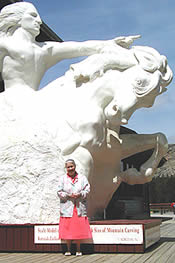 |
1/34 scale model of the finished Crazy Horse mountain carving |
With the constant growth and expansion of the visitors center, which includes the Indian Museum of North America, an 18,000 sq. ft. Education and Conference Center and Korczak's sculptors studio, Ruth is right. From the moment the first blast took place in 1948, work hasn't stopped at Crazy Horse Memorial, a touching and comprehensive tribute to Native Americans. Another part of the project still in the planning stages is the Indian University of North America and Medical Training Center.
Since Korczak was such a strong believer in the free enterprise system, he turned down offers of federal or state funding. The memorial is a nonprofit, educational and cultural financed through admission fees and donations. So in visiting Crazy Horse, not only will you have an amazing and educational experience, you'll be supporting future work on the project!
As we arrived at the Badlands National Park, I overheard a woman telling her husband, "It's like landing on the moon."
And, in a way, I found that comment to be quite on target. The Badlands, named as such by both the Lakota (mako sica) and the French (les mauvaises terres à traverser), rise up from the flat prairie defiantly, brilliantly, mysteriously and looked as rugged and empty as the moon.
Comprised of buttes, valleys, canyons and impressive jagged peaks, the Badlands National Park consists of three units totaling more than 240,000 acres. Broad regional uplift raised the land about 5 million years ago - wind and rain, over the next 5 million years continued to erode the rock and created what we now know as the Badlands.
Although the landscape may look like the moon, it's practically overflowing with animal and plant life. Buffalo, bobcats, bighorn sheep and mountain lions mingle with rabbits, prairie dogs and bats. And millions of years of history are fossilized in the Badlands, making it a valuable resource for scientists and paleontologists.
So what's there to do in the Badlands? Plenty! Hike, camp, explore the area by foot or by car (beware: summer temps can be excruciatingly hot) - just don't blink, you don't want to miss a thing!
H O T T I P : |
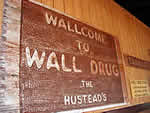 When visiting the Badlands, take the time to stop off for lunch or dinner at the nearby (and infamous) Wall Drug, where you'll find one of the tastiest buffalo burgers around. Also sample their homemade cake doughnuts and ice cream - you won't be disappointed. When visiting the Badlands, take the time to stop off for lunch or dinner at the nearby (and infamous) Wall Drug, where you'll find one of the tastiest buffalo burgers around. Also sample their homemade cake doughnuts and ice cream - you won't be disappointed. |
One of the last unexplored areas on the Earth, Jewel Cave is more than 127 miles in length (as far as it's been mapped as of yet), making it the third longest cave in the world.
"As little as 10 percent of the cave has actually been seen," National Park Ranger Merrith Baughman informed our group as we started the cave's scenic tour, a moderately strenuous half-mile loop which took us through large caverns and narrow passageways.
"A lot of people want adventure," Baughman said. "There's just something about going down into a different world."
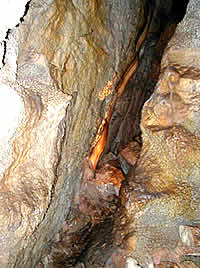 |
Formation shaped like a strip of bacon, one of the wonders of Jewel Cave |
For those interested in a more daring cave experience at Jewel Cave National Monument, there's a three-to-four hour long spelukning tour that lets visitors get down and dirty. Participants must be able to squeeze through a 8 1/2 inch by 24-inch crawlspace at the beginning of the tour. They must be in good shape and must be able to handle heights and small spaces (one length of the cave in this tour is called the "Brain Drain"), but it's guaranteed to be a once-in-a-lifetime experience.
For a different, less hands-on experience, there's the Candlelight Tour. It's still pretty strenous, as participants must carry lanterns and climb steep wooden stairs, but it gives them a chance to step back into the 1930s for almost two hours.
Whatever your taste, there's a tour at Jewel Cave that will suit you.
In summer, reservations are recommended. Call (800) 967-2283 to reserve a place on any of Jewel Cave's tours.
I had just a few goals in going to South Dakota - two big ones (seeing buffalo and prairie dogs) were met at Custer State Park, 73,000 acres of rolling terrain sprinkled with a variety of wildlife.
 |
A friendly burro curiously wanders up to our bus in Custer State Park. |
The pristine, untouched Black Hills stretched on for miles as buffalo roamed (no wonder "Home on the Range" was stuck in my head for days) and antelope gracefully hopped across the landscape.
Outdoorsy types will never want to leave - the prime attractions at Custer State Park are hiking 7,242-foot Harney Peak, mountain biking, horseback riding, rock climbing, fishing, chuckwagon suppers and jeep rides to see the bison.
There are seven campgrounds available to guests and lodging is also abundant in the park, from the B&B-style rooms and large cabins at the State Game Lodge to the dude ranch appeal of Blue Bell.
Four million visitors each year come to Rapid City to experience its history and nearby attractions (most of which have been listed previously).
The localsare extremely friendly (among the nicest I've encountered throughout my travels), the local cuisine is superb (a buffalo burger is a must) and there are two more attractions in the city that make our list.
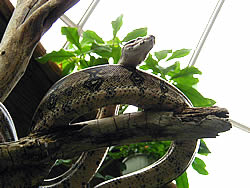 |
A snake lounges on a tree branch at Reptile Gardens. |
First off, I hate snakes. They're scarier than my frizzy out-of-control hair on a humid day. Just the thought of a small, non-venomous one is enough to make me shiver, never mind a whole building packed to the rafters (literally) with the world's most poisonous reptiles. But not being one to back down in the face of fear, I visited Reptile Gardens in Rapid City, home to eight of the 10 most venomous species of snakes in the world.
So, yes, like their tag line states, there's more than reptiles at Reptile Gardens. But the cute birds and exotic flora are not what make mouths drop open in awe. No, the vipers and pythons and rattlesnakes do that. The dozens of varieties of crocodiles and alligators do that.
There's so much to see and experience at Reptile Gardens, it's no wonder USA Today named it as one of the top 10 roadside attractions in the country.
The other must-see in Rapid City is The Journey Museum, an interactive trip through South Dakota's past, from the formation of the Black Hills to modern times, focusing on the area's rich Lakota heritage.
All in all, a road trip through the Black Hills will give visitors a taste of everything - from nature to adventure, from educational to kitschy, from spiritual to patriotic, you'll find it all in South Dakota.
IF YOU GO... |
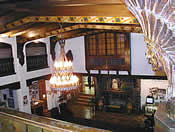 - If you're camping or using a motorhome, you won't be hard-pressed to find a place to spend the night. But if you want quality accommodations with a historical flavor, The Hotel Alex Johnson in Rapid City is the prime choice. Having hosted presidents and celebrities, it was featured in the film "North by Northwest." Located in the center of historic downtown, the hotel (founded in 1928) has 143 guest rooms and suites are decorated in lush western tones and offer room service, turn-down service, non-smoking rooms and administrative support services for business guests. Take special note of the lobby with its hand-painted ceramic tiles in traditional Sioux designs, and ceiling patterns taken from Sioux beadwork. - If you're camping or using a motorhome, you won't be hard-pressed to find a place to spend the night. But if you want quality accommodations with a historical flavor, The Hotel Alex Johnson in Rapid City is the prime choice. Having hosted presidents and celebrities, it was featured in the film "North by Northwest." Located in the center of historic downtown, the hotel (founded in 1928) has 143 guest rooms and suites are decorated in lush western tones and offer room service, turn-down service, non-smoking rooms and administrative support services for business guests. Take special note of the lobby with its hand-painted ceramic tiles in traditional Sioux designs, and ceiling patterns taken from Sioux beadwork.
- You don't have to make a trip to the Black Hills by car. The Rapid City Regional Airport is serviced by Northwest, United and Delta. Rental cars are available.
- Peak travel is, obviously, in the summer months. You can find great deals in the off-season, but not everything is open in the winter. |
|